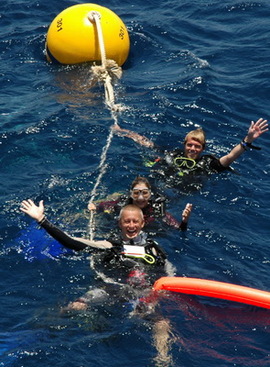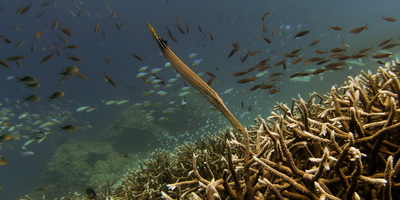Phuket Dive Guide : Shark point

About the location and site
The official Thai name ‘Hin Musang’ translates ‘Shark Rock’, named after the local leopard sharks that sometimes visit the location and can be seen resting on the sandy seafloor. The sharks are not the only attraction here though; Shark Point is one of the richest and most vivid dive spot around, with its stunning soft corals, fan corals, and anemones.
The site lies 29 km from Chalong Bay, Phuket. It became part of a Marine Sanctuary in 1992; the sheer profusion of marine life is justification enough for protection. The exclusion area extends as a radius of 2.5km around the western limits of shark point and all commercial fishing, collection or marine organism or any other harmful activity is prohibited by law.
Shark Point consists of 3 remote pinnacles running north to south. Pinnacle 1, as the main site, is identified by a small rock on the surface with a cross to warn off local boat traffic. Considering the small extent of the rock above water, the actual size of the reef underwater is a big surprise to most divers. Depths range between of 18-20 metres with a good visibility from 5-25 metres. Currents can be brisk at this site but they tend run parallel to the reef sections and allow for an excellent drift dive back to the dive boat.
The official Thai name ‘Hin Musang’ translates ‘Shark Rock’, named after the local leopard sharks that sometimes visit the location and can be seen resting on the sandy seafloor. The sharks are not the only attraction here though; Shark Point is one of the richest and most vivid dive spot around, with its stunning soft corals, fan corals, and anemones.
The site lies 29 km from Chalong Bay, Phuket. It became part of a Marine Sanctuary in 1992; the sheer profusion of marine life is justification enough for protection. The exclusion area extends as a radius of 2.5km around the western limits of shark point and all commercial fishing, collection or marine organism or any other harmful activity is prohibited by law.
Shark Point consists of 3 remote pinnacles running north to south. Pinnacle 1, as the main site, is identified by a small rock on the surface with a cross to warn off local boat traffic. Considering the small extent of the rock above water, the actual size of the reef underwater is a big surprise to most divers. Depths range between of 18-20 metres with a good visibility from 5-25 metres. Currents can be brisk at this site but they tend run parallel to the reef sections and allow for an excellent drift dive back to the dive boat.
This large dive site has three main sections or pinnacles. Starting from the relatively steep main pinnacle 1, the reef flattens out to the south rising two more times to just below the surface at the other two pinnacles that make up the reefs structure. Depending on the currents, the second pinnacle can also be an excellent place to start the dive.
The main attraction here, in addition to sharks and vast schools of tropical fish are the colorful soft corals and sea fans that decorate the huge limestone pinnacles. The currents sweeping over the pinnacles provide enough food for the hundreds of different species of hard corals and limitless tropical fish species. Most divers could spend several dives exploring the many interesting facets of the site, which is arguably the most popular of all the local day-diving sites. Diving with Nitrox for longer bottom time is advisable.
The leopard shark is a docile creature that can be found lying in the sandy bottom surrounding the pinnacles. These completely reachable, trusting sharks grow to a length of a little over 2 meters, and most divers think that they are one of the "cutest" sharks in the ocean. Divers who are not accustomed to seeing sharks are genuinely surprised at how big and approachable they are. Because they are nocturnal feeders, they are very approachable during the day.
The main attraction here, in addition to sharks and vast schools of tropical fish are the colorful soft corals and sea fans that decorate the huge limestone pinnacles. The currents sweeping over the pinnacles provide enough food for the hundreds of different species of hard corals and limitless tropical fish species. Most divers could spend several dives exploring the many interesting facets of the site, which is arguably the most popular of all the local day-diving sites. Diving with Nitrox for longer bottom time is advisable.
The leopard shark is a docile creature that can be found lying in the sandy bottom surrounding the pinnacles. These completely reachable, trusting sharks grow to a length of a little over 2 meters, and most divers think that they are one of the "cutest" sharks in the ocean. Divers who are not accustomed to seeing sharks are genuinely surprised at how big and approachable they are. Because they are nocturnal feeders, they are very approachable during the day.








